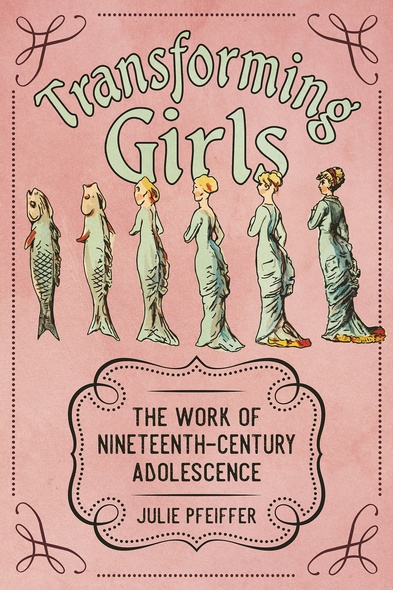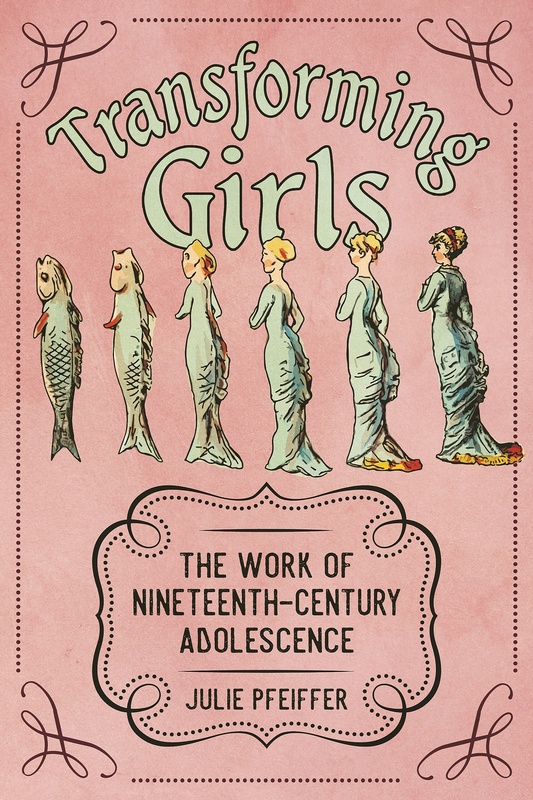
Transforming Girls
The Work of Nineteenth-Century Adolescence
Transforming Girls: The Work of Nineteenth-Century Adolescence explores the paradox of the nineteenth-century girls’ book. On the one hand, early novels for adolescent girls rely on gender binaries and suggest that girls must accommodate and support a patriarchal framework to be happy. On the other, they provide access to imagined worlds in which teens are at the center. The early girls’ book frames female adolescence as an opportunity for productive investment in the self. This is a space where mentors who trust themselves, the education they provide, and the girl’s essentially good nature neutralize the girl’s own anxieties about maturity.
These mid-nineteenth-century novels focus on female adolescence as a social category in unexpected ways. They draw not on a twentieth-century model of the alienated adolescent, but on a model of collaborative growth. The purpose of these novels is to approach adolescence—a category that continues to engage and perplex us—from another perspective, one in which fluid identity and the deliberate construction of a self are celebrated. They provide alternatives to cultural beliefs about what it was like to be a white, middle-class girl in the nineteenth century and challenge the assumption that the evolution of the girls’ book is always a movement towards less sexist, less restrictive images of girls.
Drawing on forgotten bestsellers in the United States and Germany (where this genre is referred to as Backfischliteratur), Transforming Girls offers insightful readings that call scholars to reexamine the history of the girls’ book. It also outlines an alternate model for imagining adolescence and supporting adolescent girls. The awkward adolescent girl—so popular in mid-nineteenth-century fiction for girls—remains a valuable resource for understanding contemporary girls and stories about them.
Pfeiffer’s book is a dense, discursive and thoroughly researched argument for a better way of approaching adolescence. . .it is also a persuasive thesis on the work of rearing girls that, ideally, could change attitudes not only to adolescence but to the adolescent we all carry within us.
Pfeiffer provides excellent resources and in-depth analysis of eight novels, both German and American, of this little-known, understudied genre, making this book a vital addition to the study of girls’ literature. Essential.
Pfeiffer’s beautifully-written Transforming Girls cracks open the canon of the girls’ book to present the neglected German-American Backfisch book as a vibrant genre focused on active, well-mentored adolescent girl protagonists. It presents an alternative, fluid model of adolescent girlhood within the nineteenth-century United States and emphasizes womanhood as a transformational process requiring hard work and perseverance. Perhaps most significantly, Transforming Girls provides a model both for examining neglected genres, and for the scholarly willingness to research and write against academic narratives we perceive as set or standard.
Transforming Girls is a remarkable example of scholarship that points to new ways of understanding girls’ books and adolescence in fiction, as well as contemporary adolescents more generally.
Pfeiffer’s book is a compelling study about a subgenre of girls’ literature oft overlooked. . . . The Backfisch book ultimately ascertains women and girls had a significant place in history, and Pfeiffer shows there was, and still is, a consumer need for these stories.
Drawing on her own reading history, her devotion to nineteenth century girls’ books, overseas research opportunities, and her affinity for German texts and German culture, Julie Pfeiffer offers an analysisof the ‘Backfisch’ tradition of girls’ books that will have broad appeal.
In Transforming Girls, Pfeiffer examines an illuminating subgenre, effectively demonstrating origins for what would now be identified as girls’ bildungsroman by showing its roots in a specific German tradition, the backfisch novel.
[Pfeiffer’s] approach to the issue of girlhood in the above-mentioned novels is fresh and innovative: by exploring the stories of 19th-century heroines, she shows us that these works were often more progressive and emancipatory than both scholars and readers might have expected. Transforming Girls: The Work of Nineteenth-Century Adolescence is a captivating addition to both the field of comparative literature and the history of literature.
Transforming Girls has the potential to shift the way we think about girlhood reading and adolescence while carving out a different kind of conceptual space for adolescent girls—one that fosters growth while embracing the ‘messiness’ of the transition to adulthood.
By situating the backfisch into a backdrop of well-established texts and critical lenses, Pfeiffer gently but insistently asks scholars to reconsider many of the critical assumptions our understandings of adolescent and nineteenth-century literature have been built upon.
Julie Pfeiffer is professor of English at Hollins University. She is editor of Children’s Literature, the annual of the Children’s Literature Association.




